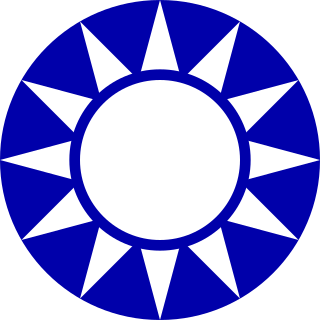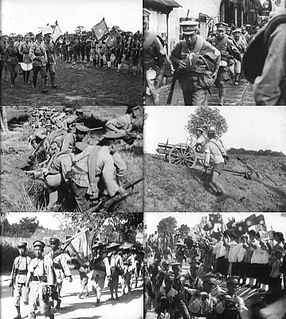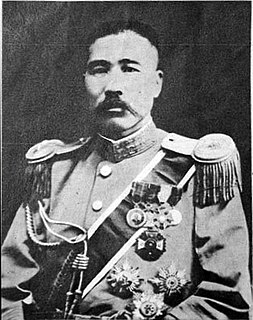 W
WThe Spirit Soldier rebellions of 1920–1926 were a series of major peasant uprisings against state authorities and warlords in the Republic of China's provinces of Hubei and Sichuan during the Warlord Era. Following years of brutal suppression, civil war, and excessive taxation, the rural population of central China was restive, and susceptible to militant salvationist movements. One spiritual group, the so-called Spirit Soldiers, promised the peasants that they could gain protection from modern weaponry through protective magic. Tens of thousands consequently rallied to join the Spirit Soldiers, and successfully revolted in the mountainous and isolated areas of Hubei and Sichuan. At its height, the Spirit Soldier movement numbered over 100,000 fighters, and controlled about forty counties.
 W
WThe Battle of Baitag Bogd Mountain or Beitashan Incident was a border conflict between China, Mongolia, and the Soviet Union. The Mongolian People's Republic became involved in a border dispute with the Republic of China, as a Chinese Muslim Hui cavalry regiment was sent by the Chinese government to attack Mongol and Soviet positions.
 W
WThe Central Plains War was a series of military campaigns in 1929 and 1930 that constituted a Chinese civil war between the Nationalist Kuomintang government in Nanjing led by Generalissimo Chiang Kai-shek and several regional military commanders and warlords that were former allies of Chiang.
 W
WThe Chinese Civil War was a civil war in China fought between the Kuomintang (KMT)-led government of the Republic of China (ROC) and the Communist Party of China (CPC) lasting intermittently between 1927 and 1949. The war is generally divided into two phases with an interlude: from August 1927 to 1937, the KMT-CPC Alliance collapsed during the Northern Expedition, and the Nationalists controlled most of China. From 1937 to 1945, hostilities were put on hold, and the Second United Front fought the Japanese invasion of China with eventual help from the Allies of World War II. The civil war resumed with the Japanese defeat, and the CPC gained the upper hand in the final phase of the war from 1945 to 1949, generally referred to as the Chinese Communist Revolution.
 W
WThe Han–Liu War was a major military conflict in late 1932 between the private armies of Han Fuju and Liu Zhennian over Shandong. Even though Han as well as Liu were officially subordinates to the Chinese Nationalist government in Nanjing, both were effectively warlords with their own autonomous territories. Han Fuju controlled most of Shandong and had long desired to also capture the eastern part of the province, which was held by Liu. The tensions between the two eventually escalated, leading to a war that saw Han emerge victorious. He went on to rule Shandong unopposed for the next six years, while Liu was exiled to southern China.
 W
WIn 1937 an Islamic rebellion broke out in southern Xinjiang. The rebels were 1,500 Turkic (Uighur) Muslims led by Kichik Akhund, tacitly aided by the 36th Division against the pro-Soviet provincial forces of Sheng Shicai.
 W
WThe Kuomintang Islamic insurgency refers to a continuation of the Chinese Civil War by Chinese Muslim nationalist Kuomintang Republic of China Army forces in Northwest China, in the provinces of Gansu, Qinghai, Ningxia, and Xinjiang, and another insurgency in Yunnan.
 W
WThe National Protection War, also known as the anti-Monarchy War, was a civil war that took place in China from 1915–1916. Only three years earlier the last Chinese dynasty, the Qing dynasty, had been overthrown and the Republic of China established in its place. The cause of the war was the proclamation by Yuan Shikai, the President of the Republic, of himself as the Hongxian Emperor, Emperor of the Empire of China.
 W
WThe Ngolok rebellions (1917–1949) were a series of military campaigns against unconquered Ngolok (Golok) tribal Tibetan areas of Qinghai (Amdo), undertaken by two Hui commanders, Gen. Ma Qi and Gen. Ma Bufang, on behalf of the Beiyang and Kuomintang governments of the Republic of China. The campaigns lasted between 1917 and 1949.
 W
WThe Northern Expedition was a military campaign launched by the National Revolutionary Army (NRA) of the Kuomintang (KMT), also known as the "Chinese Nationalist Party", against the Beiyang government and other regional warlords in 1926. The purpose of the campaign was to reunify China, which had become fragmented in the aftermath of the Revolution of 1911. The expedition was led by Generalissimo Chiang Kai-shek, and was divided into two phases. The first phase ended in a 1927 political split between two factions of the KMT: the right-leaning Nanjing faction, led by Chiang, and the left-leaning faction in Wuhan, led by Wang Jingwei. The split was partially motivated by Chiang's purging of communists within the KMT, which marked the end of the First United Front. In an effort to mend this schism, Chiang Kai-shek stepped down as the commander of the NRA in August 1927, and went into exile in Japan.
 W
WThe Second Sino-Japanese War (1937–1945) was a military conflict that was primarily waged between the Republic of China and the Empire of Japan. In China, the war is known as the War of Resistance against Japanese Aggression, or as the oriental theatre of the World Anti-Fascist War, the latter term originating from Mao Zedong's wartime alliance with Stalin. The beginning of the war is conventionally dated to the Marco Polo Bridge Incident 7 July 1937, when a dispute between Japanese and Chinese troops in Peking escalated into a full-scale invasion. In 2017 the Ministry of Education in the People's Republic of China decreed that the term "eight-year war" in all textbooks should be replaced by “fourteen-year war", with a revised starting date of 18 September 1931 provided by the Japanese invasion of Manchuria. According to historian Rana Mitter, historians in China are unhappy with the blanket revision, and the Republic of China did not consider itself to be continuously at war with Japan over these six years.
 W
WThe Sino-Soviet conflict of 1929 was an armed conflict between the Union of Soviet Socialist Republics and Chinese warlord Zhang Xueliang of the Republic of China over the Chinese Eastern Railway.
 W
WThe Sino-Tibetan War was a war that began in 1930 when the Tibetan Army under the 13th Dalai Lama invaded Xikang and Yushu in Qinghai in a dispute over monasteries. Ma clique warlord Ma Bufang secretly sent a telegram to Sichuan warlord Liu Wenhui and the leader of the Republic of China, Chiang Kai-shek, suggesting a joint attack on the Tibetan forces. Their armies rapidly overwhelmed and defeated the Tibetan Army.
 W
WThe war in Ningxia of 1934, also known as Sun Dianying Campaign, was a minor civil war for control over the Republic of China's province of Ningxia, fought between the warlord Sun Dianying and an alliance against him, consisting of the Ma clique, Governor Yan Xishan of Shanxi, and the Nationalist government of China. The conflict erupted as the unintended consequence of a plan by China's supreme leader, Chiang Kai-shek, to weaken the Ma clique, and resulted in the destruction of Sun Dianying's private army.
 W
WThe Warlord Rebellion in northeastern Shandong was an uprising of several allied Chinese warlord armies under the leadership of Zhang Zongchang in 1929. The rebels wanted to regain their former territories in Shandong from Liu Zhennian, the man who had defected from Zhang to the Nationalist government in Nanjing during the Northern Expedition. After some initial successes, the rebels were defeated due to the indiscipline of their forces. In the end, the uprising failed to topple Liu Zhennian's rule over eastern Shandong, but resulted in high civilian casualties and widespread destruction at the hands of both sides in the conflict.
 W
WWorld War I was a global war originating in Europe that lasted from 28 July 1914 to 11 November 1918. Contemporaneously known as the Great War or "the war to end all wars", it led to the mobilisation of more than 70 million military personnel, including 60 million Europeans, making it one of the largest wars in history. It is also one of the deadliest conflicts in history, with an estimated 9 million combatant deaths and 13 million civilian deaths as a direct result of the war, while resulting genocides and the related 1918 Spanish flu pandemic caused another 17–100 million deaths worldwide, including an estimated 2.64 million Spanish flu deaths in Europe and as many as 675,000 Spanish flu deaths in the United States.
 W
WWorld War II, also known as the Second World War, was a global war that lasted from 1939 to 1945. It involved the vast majority of the world's countries—including all the great powers—forming two opposing military alliances: the Allies and the Axis. In a state of total war, directly involving more than 100 million personnel from more than 30 countries, the major participants threw their entire economic, industrial, and scientific capabilities behind the war effort, blurring the distinction between civilian and military resources. World War II was the deadliest conflict in human history, resulting in 70 to 85 million fatalities, with more civilians than military personnel killed. Tens of millions of people died due to genocides, premeditated death from starvation, massacres, and disease. Aircraft played a major role in the conflict, including in strategic bombing of population centres, and the only uses of nuclear weapons in war.